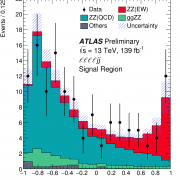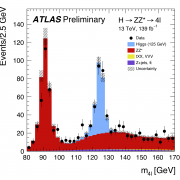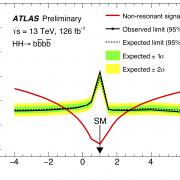Access to Collaboration Site and Physics Results

The discovery of a Higgs boson in 2012 by the ATLAS and CMS experiments marked a key milestone in the history of particle physics. It confirmed a long-standing prediction of the Standard Model, the theory that describes our present understanding of elementary particles and their interactions.
The LHC’s jump in energy to 13 TeV in Run 2, together with the copious amount of collisions delivered over the last 12 months, has allowed the ATLAS experiment to collect a data sample that is more than equivalent to the one collected during Run 1.

The Higgs boson channels with decays into either two photons (H→γγ) or four leptons (H→ZZ→4l) offer the clearest signature. They both show a narrow resonant peak in the reconstructed invariant mass as illustrated in Figures 1 and 2. For an assumed Higgs boson mass value of mH=125.09 GeV, which was measured from the data collected in Run 1, the statistical significance of the observed excess over the background prediction from the combination of the H→γγ and H→ZZ→4l channels is approximately 10σ and thus well beyond the 5σ threshold for a (re-)discovery.
Figure 3 shows the measurement of the inclusive Higgs boson production cross section from both channels at center-of-mass-energies of 7 and 8 TeV (Run 1) as well as 13 TeV (Run 2). The measurements are compatible with Standard Model predictions at all three center-of-mass-energies.

ATLAS also measured the cross sections for the two dominant Higgs boson production modes through the fusion of either gluons (ggF) or vector bosons (VBF). These measurements could reveal deviations from the Standard Model in the way the Higgs boson couples to fermions and weak intermediate vector bosons (W,Z). Figure 4 shows that the simultaneous measurements of both cross sections from the H→γγ and H→ZZ→4l channels are also compatible with Standard Model expectations.
The Higgs boson decay mode into b-quark pairs (H→bb) is dominant in the Standard Model, making up ~60% of the total Higgs boson branching fraction. However, due to large backgrounds and a challenging experimental signature, the LHC is not sensitive to the search for H→bb in the dominant ggF production process. Instead, H→bb searches are performed in associated production with vector bosons (VH) or top quarks (ttH), as well as in the VBF production mode. The searches performed during Run 1 of the LHC were not sufficiently sensitive to find evidence of the H→bb decay mode. During Run 2, ATLAS has performed further searches for this decay mode using the VH and ttH associated production modes. The result with the present data sample still does not establish the H→bb decay mode.
To strengthen this investigation, a new search has been conducted for this Higgs boson decay, in association with a hard photon in the VBF production mode. This analysis is not yet at the level of sensitivity needed for the Standard Model, but has great future potential.

Links:
- Searches for VBF Higgs production with a photon (ATLAS-CONF-2016-063): https://atlas.web.cern.ch/Atlas/GROUPS/PHYSICS/CONFNOTES/ATLAS-CONF-2016-063/
- Measurements of Higgs couplings in the 4-lepton channel (ATLAS-CONF-2016-079): https://atlas.web.cern.ch/Atlas/GROUPS/PHYSICS/CONFNOTES/ATLAS-CONF-2016-079/
- Searches for VH production with Higgs decays to bb (ATLAS-CONF-2016-091): https://atlas.web.cern.ch/Atlas/GROUPS/PHYSICS/CONFNOTES/ATLAS-CONF-2016-091/
- Measurements of Higgs couplings in the diphoton channel (ATLAS-CONF-2016-067): https://atlas.web.cern.ch/Atlas/GROUPS/PHYSICS/CONFNOTES/ATLAS-CONF-2016-067/
- Combination of Higgs measurements in the 4-lepton and diphoton channels (ATLAS-CONF-2016-081): https://atlas.web.cern.ch/Atlas/GROUPS/PHYSICS/CONFNOTES/ATLAS-CONF-2016-081/
- Find all ATLAS 13 TeV results for 2016 summer conferences: https://twiki.cern.ch/twiki/bin/view/AtlasPublic/Summer2016-13TeV








